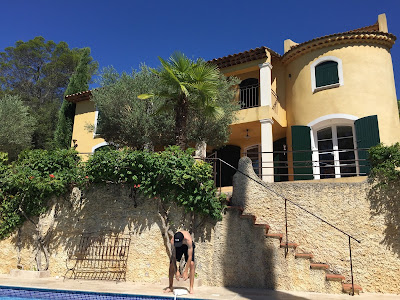This particular tasting was to focus on the Moulin-a-Vent wines from Domaine Labruyere and was very well led by Nicolas Mielly who got the balance between information and passion just right (not always easy!).
A few key dates for Domaine Labruyere.
1850 - The estate started
2001 - They took after the monopole of "Les Clos"
2008 - Edouard Labruyere took over the running of the families wine estates
A run through of some recent vintages was then summed up as follows:
2009 - mature fruits
2010 - Serious
2011 - balanced
2012 - 50% lost...
The 2014 vintage: Budbreak was early, suggesting an early vintage but flowering was about average, beginning early April. Cooler weather in July and August slowed down véraison which started at the end of July. The conditions in July and August, predominantly cooler than average, brought the risk of disease. September, happily, was sunny, hot and dry with higher than average temperatures and very little rain. Picking began on the 11th September, all harvested by hand into small cagettes. The bunches were small, the grapes, big, ripe, healthy and juicy. Harvest lasted 10 days.
A note on scoring... Recently I have been slightly "mucking about" with scoring a few tastings/wines out of 25 rather than 20 as I tend to find that the 16-18 range gets used the whole time when scoring out of 20 and therefore the differentiation is less. I used the 25 point scale for this tasting. There is something of a threshold to the 20 out of 25 level but I feel it is a more useful threshold than the 90 out of 100 mark.
Moulin-a-Vent Coeur de Terroir 2014
This is from a selection of 5 plots, matured 50% in vats 50%
in barrel – only 3% of which is new wood. Bottled back in December. Good acidity, lifted, cool red fruits and a slightly ferrous note, a little spice also. Really balanced, strong start. 17/25
Moulin-a-Vent Champ de Cour 2014
Interestingly, this is the only wine where 100% whole bunches are used, lifting the style of a wine which originates from heavy clay. At the estate they often compare this to Clos Vougeot. There is more depth, spice too, some good greener notes of freshness and then a wave of darker more serious fruit. There is good mineral drive and a persistent tension – this warrants patience. 18/25
Moulin-a-Vent Le Carquelin 2014
This is very different in style, after the Champ de Cour. This is from vines on sandy, granite soils, just near the famous windmill. 5-6% new oak, this was first made in 2011 and is 100% de-stemmed. More lifted, almost orange citrus notes. Then depth on the palate, richer texture but less spice showing. More fruit generally as a balance to the iron that is in there. 18+/25
Moulin-a-Vent Clos du Moulin-a-Vent Monopole Domaine Labruyere 2014
A beautiful colour, Le Clos is aged in barrels, 15% of which are new, others 1 to 2 years old – all coming from Domaine Jacques Prieur. These vines are grown on more sandy soils. This is a very "grown up" wine, serious, superbly concentrated with a wonderful texture, complexity and an iron like grip – rather northern Rhône-esque. 20-21/25
It was a very good tasting. I am the first to admit that I had rather dismissed the wines of Beaujolais (much to the frustration of mates in the trade) until I came across these.
It was too good an opportunity not to re-taste the Rouget 2015, last tasted in Bordeaux during this tasting trip.
Chateau Rouget 2015 - 85% Merlot and 15% Cabernet Franc with 30% new oak. In 2015 60% of the wine made it to the Grand Vin the remaining 40% being designated as "Le Carillon de Rouget". It is a superb wine, arguably one of the very best value buys of the whole campaign at about £350 a dozen (well I bought it). Rich and full but not without balance it is wine I intend to leave a good while!





















































